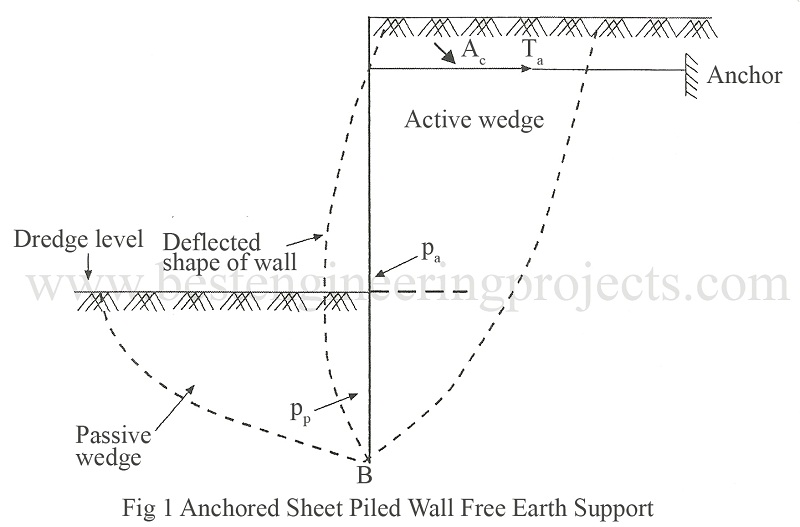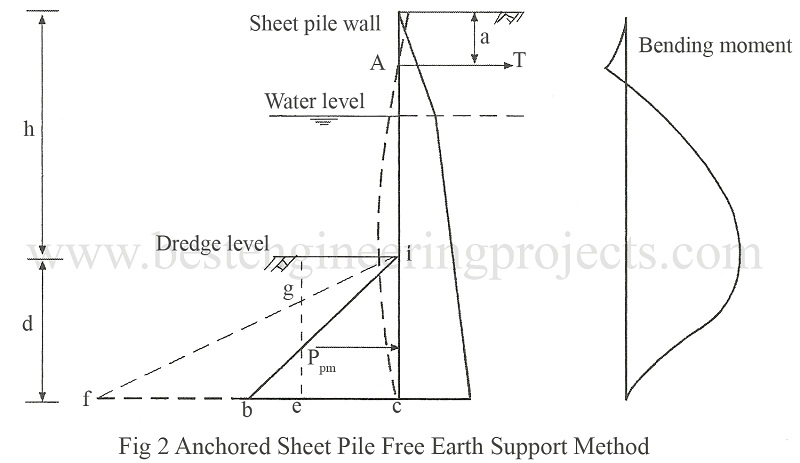What is anchored bulkhead?
If tie rods or anchor rods are anchored close to the upper ends of sheet pile walls, the sheet pile walls are called bulkheads or anchored sheet pile walls. The tie or anchor rods are buried in the backfill at a considerable distance from the back of the wall. The ties or anchored rods reduce the lateral deflection, the bending moment and the depth of penetration.
Anchored bulkhead are extensively used in water front structures. They are constructed by driving a row of sheet pile to the required depth. The soil in front of the wall is dredged out to required depth in front of the wall and behind the wall it is backfilled by suitable soil. The wall is supported at the top by tie rods and at the bottom by passive earth resistance.
How Anchored Bulkhead determined?
In anchored bulkheads the depth of penetration is determined by:
- The free earth support method
- The fixed earth support method
Free Earth Support Method
In free earth support method the depth of penetration is not sufficient to provide end restraint. The wall is assumed to be freely supported by tie rods at the top and by the passive earth resistance of soil at the bottom. The forces acting on the wall as well as the deflected shape of the wall are shown in Fig.1 below.
The various notations shown in the figure 2 are described below.
T = Tension in the tie rod per unit length
d = Depth of penetration below dredge line
pa = Active pressure in the wall
ppm = Mobilized passive resistance =
The depth of penetration d is found out by taking moment of all forces about the line of action of the tie rod.
Or,
Once d is known, the tension in the tie rod is found out by summing all the horizontal forces i.e.,
pa – ppm – T = 0
In order to guard excess dredging, scouring and presence of pockets of weak soils the depth of penetration is increased by 20 to 40 %. With this increasing the depth of penetration, a factor of safety of 1.5 to is ensured.
Fixed Earth Support Method
In fixed earth support method, the depth of penetration is adequate and soil below the dredge line provides considerable anchorage. The wall acts as a propped cantilever beam and cannot rotate freely at its lower end as shown in Fig.3 and the point of contra flexure lies close to the dredge line.
Prevention of free rotation at the bottom develops full passive resistance at the back of the wall above the lower end. This resistance is replaced by a concentrated force RD at 0.2 d above the lower end of the pile.
Analysis of Anchored Bulkhead
In the analysis, two beams, one above the point of contraflexure and another below the point of contraflexure, are considered. The position of the point of contraflexure, y is a function of angle of internal friction of the soil . For sands, y is given by,
|
|
20 |
30 |
40 |
|
y |
0.25 h |
0.08 h |
-0.006 h |
For approximate analysis ‘y’ may be assumed as zero and the point of contrafiexure lie at the dredge level.
By considering the upper beam, the unknown forces RC and T can be found out by M and
H = 0. In the case of lower beam as shown in Fig.3 force RD and depth of penetration d are not known. By taking moment of all forces about the base of the pile the depth of penetration can be found out. The depth of penetration thus obtained by fixed earth support method is increased by 20 to 40 %.
Check out other top popular Articles :
Clock Signal Generator Circuit


